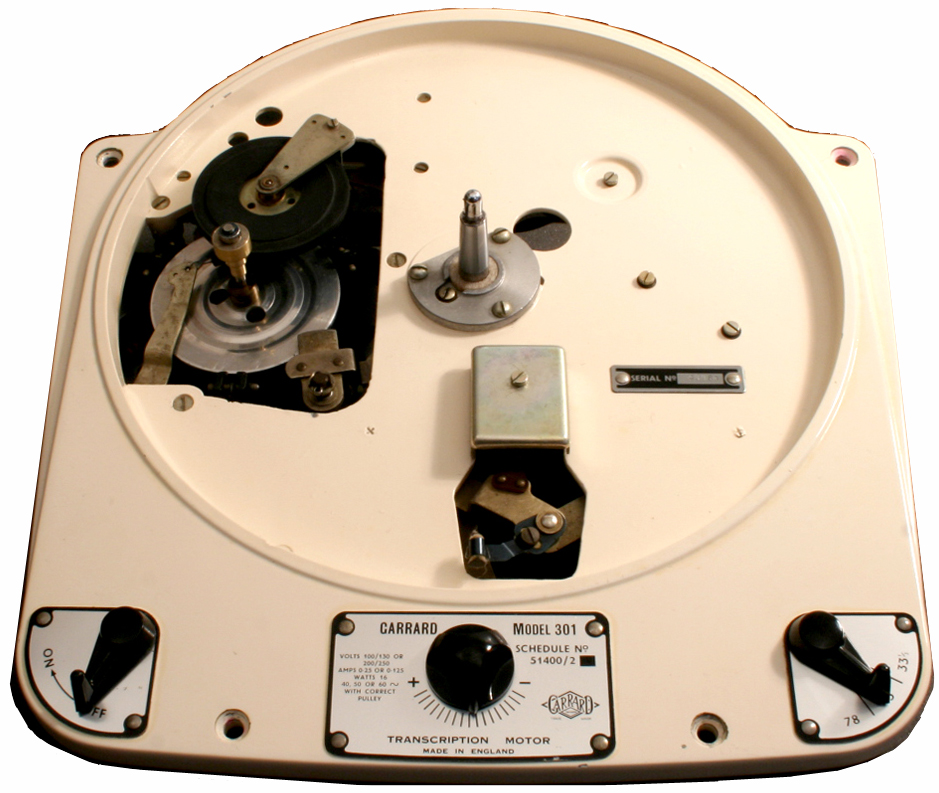|
Garrard 301
Transcription Turntable
The term “transcription turntable” should be reserved for the turntables made for playing records at 16 2/3 rpm speed, used in 1940’s and 1950’s in radio stations and named transcription records. Nevertheless it is applied also to tables that play multiple speeds (78,45,33 rpm). The Garrard 301, manufactured by the Garrard Engineering and Manufacturing Company Ltd of Swindon (G.B.), was introduced in 1954. The model stayed in production until to 1970’s. Garrard used the idler drive system ( the alternating current motor is engaged to an intermediate, the idler wheel, to rotate the platter). This system ensures must speed accuracy and good wow/flutter specifications. The 301 supports the 33,45 and 78 rpm commercial formats. Il termine “transcription turntable” andrebbe riservato solo ai giradischi in grado di utilizzare dischi con velocità 16 2/3 rpm,usati negli anni 40 e 50 nelle stazioni radio e appunto chiamati “transcription records”. Tuttavia esso viene anche utilizzato per quei giradischi che hanno diverse velocità (78,45,33 giri) Il Garrard 301, fabbricato dalla Garrard Engineering and Manufacturing Company Ltd -Swindon (G.B.), fu introdotto sul mercato nel 1954 e restò in produzione fino agli anni 70. Garrard ha sempre utilizzato il sistema “idler drive” (il motore a corrente alternata è solidarizzato con un componente intermediario, la cosiddetta idler wheel, che assicura la rotazione del piatto. Il sistema consente una maggiore precisione della velocità e migliori prestazioni di wow e flutter. Il modello 301 consente l’utilizzo di dischi a 78,45 e 33 giri.
An idler-wheel drive is a system used to transmit the rotation of the main shaft of a motor to another rotating device (idler wheel). The idler is engaged to the platter. Il sistema idler-wheel utilizza un componente rotatorio intermedio per trasmettere la rotazione del motore. L’idler wheel è solidarizzata al piatto.
It may recognize different versions of the Garrard 301, according to the color, spindle lubrications, schedule number on the front label, color of the labels, platter, etc.
Si possono riconoscere diverse versioni del Garrard 301, distinguibili dal colore, il tipo di lubrificazione del perno, il numero di scheda sulla targhetta centrale del frontale, il colore delle targhette, il tipo di piatto, etc. · Nella versione più antica il colore è grigio/argento con vernice antiruggine Hammerite (Hammerite è un prodotto protettivo contro la ruggine verniciato sulla superficie). Successivamente Garrard utilizzò una vernice a base di olio color crema. Negli ultimi modelli fu invece utilizzata vernice bianca. · Il perno ha una lubrificazione a base di grasso (grease bearing) nelle versioni più vecchie e a base di olio (oil bearing) nelle versioni più recenti. La prima è facilmente riconoscibile per la presenza appunto di un serbatoio di rame con un tappo presente sul lato interno. Ruotando il tappo si può introdurre il grasso nel sistema del perno. · In conformità con il tipo di lubrificazione del perno, lo “schedule number” presente sulla targhetta centrale del frontale è sempre 51400/1 nelle versioni grease bearing, 51400/2 nelle versioni oil bearing. · Le targhette dei controlli sul frontale (accensione, regolazione fine della velocità, selettore delle velocità 33,45,78 giri) nella versione iniziale sono di colore nero con scritte argento (le lettere sono in rilievo). Esse rimasero tali all’inizio della produzione per poi cambiare (fondo argento e scritte nere non in rilievo). Nelle versioni più tardive le targhette tornarono ad essere di colore nero con scritte argento ma non a rilievo. · Il piatto nella versione iniziale è privo di stroboscopio che fu poi introdotto nelle versioni successive.
(The picture don’t show the 5.th version : white color paint, oil bearing, silver on black text)
Summary
*Hammerite is a protective compound and it can be painted directly onto rusty surface.
LINK http://www.slatedeck.com/turntables/which%20301.html
http://www.members.iinet.net.au/~quiddity/audio/Garrard301_2.html
Is available on request the manual (2.nd Ed.-1956 or 6.th Ed. 1961)
|








